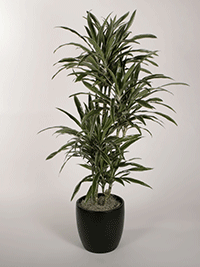
Dracaena Warneckii has fragile leaves
You can always tell a novice plant technician by the way they handle plants.
“Oops, sorry! I guess those were some leaves I heard crunching when I grabbed the plant by its sleeve.”
“Oops, would you look at that! I guess it isn’t rooted well enough to carry it by its canes.”
Even experienced technicians sometimes make mistakes, especially when in a hurry.
“Oops, darn! The plant’s taller than the doorway when I’m carrying it.”
New plants with developing roots and newly emerging growth can become stressed if damaged during transport or installation. Keep your new plant healthy by learning the correct way to handle fragile plant material and then remember to use what you’ve learned every day. If you’re in a hurry, you won’t save any time if you have to repair the plant when it finally reaches its destination.
Eliminate damage
Provide proper insulation from fluctuating temperatures: excessively hot temperatures can dry out and damage developing leaf buds and root systems; cold temperatures can damage plant tissue and promote infectious root and stem rots. Protect individual plants with plant sleeves and boxes; transport plant material in an environmentally controlled vehicle. Warm your vehicle before you put in the plants in the winter and use your air conditioner or open your windows a bit for ventilation on hot summer days. Try and arrange deliveries so that the plant spends as little time in the vehicle as possible during extreme temperatures.
Protect plants from mechanical damage: protect lateral branches and newly emerging growth from damage by tying or sleeving the foliage canopy. Provide support for top heavy, under-rooted new plants by staking loose canes and trunks or adding additional media to container. Try stuffing foam rubber or paper at the base of the plants to help stop soil from spilling out and canes or stems from wobbling.
Secure plants in your vehicle to prevent plants from rolling or falling over. If the plant is on its side you can wedge some foam rubber or even a bag of soil up next to its pot to keep it from rolling. Pack plants as close together as possible and as near the front of the vehicle as possible and they can help brace each other against the back of the front seats. Do not crowd plants with brittle stems (many flowering plants; Ficus decora; Codiaeum variegatum) that break off easily if handled roughly. Remember to prop something behind them so that no matter which way you turn, stop or start, the plants won’t tip or roll.
Transport carefully
Carry and lift plants properly. Dropping plant containers or dragging plants by their stems or trunks can damage developing root systems. Learning to lift and carry plants properly protects not only the plant but also your back as well. Keep your back straight, bend your knees and squat down to pick up a plant container. Getting a firm grip on the pot, hug the pot to your chest and stand up slowly, using your leg muscles. To help keep your back straight during lifting, keep your eyes straight ahead; do not look down. Use a plant cart or dolly if plant is too heavy or this maneuver is too difficult for you.
Remove plant sleeves properly. Plant sleeves, used during transport to protect the plant, can cause damage to the foliage if removed incorrectly. Remove paper or stiff plastic sleeves by gently tearing or cutting along seam, starting at the bottom end. Remove fiber sleeves by holding the bottom of the pot in one hand and gently wiggling the plant upwards, peeling the sleeve downward with the other hand.
Still learning
Look around and be aware of your surroundings. Watch how your supervisor and other plant technicians carry plants to get ideas. Pack them well to protect you and your plants from rolling around or sliding in your vehicle. Remember, inside that sleeve is a living plant, treat it with loving care to get it off to a good start in its new home.
